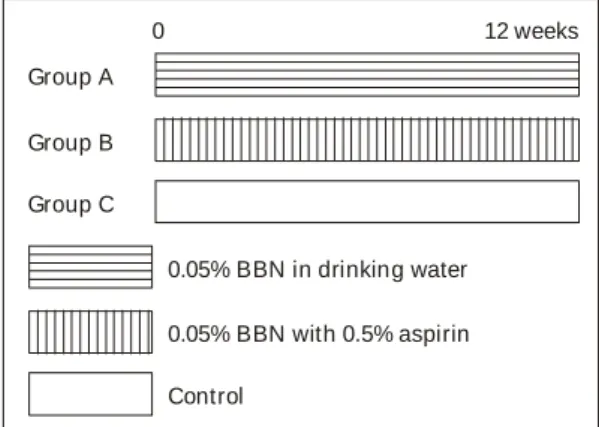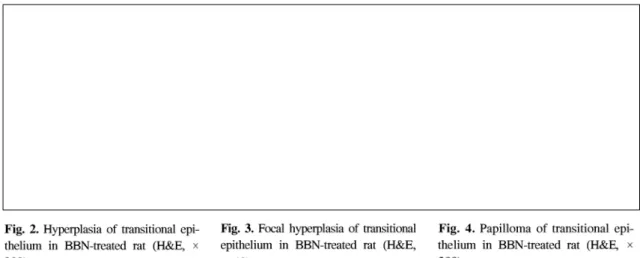of Cancer Prevention 2000; 5(2): 65-70
INTRODUCTION
Bladder cancer is the most common tumor of urological cancers in Korea.
1)Chemoprevention is a rapidly expanding field that promises the hope and potential one in the management of cancer.
2,3)The concept of field cancerization states that an entire area of epithe- lium exposed to a carcinogen is at risk of de- veloping cancer. Such changes are associated with subsequent high risk for development of tumor recurrence.
4)Many clinical trials of chem-
opreventive agents are now ongoing in various sites of cancer, including the urinary bladder.
6,7)Chemoprevention agents, including specific vita- mins, natural products or toxicologically well- known drugs, are alluring agents in controlling the recurrence of urothelial tumors. Effective chem- oprevention by non-steroidal antiinflammatory drugs (NSAIDs) has been demonstrated in experi- mental models for cancer of colon, urinary bladder and esophagus among other tissues.
2,6,7)Aspirin is included in this class of compound noted for antitumor activity. Aspirin has significant
The Effect of Aspirin on Preneoplastic Lesions in Rat Bladder Induced by N-Butyl-N-(4-hydroxybutyl) Nitrosamine
Gil Ho Lee, In Ho Sohng, Hyung Jee Kim and Min Chul Lee
1Department of Urology,
1Department of Anatomic Pathology, Dankook University
College of Medicine, Cheonan 330-714, Korea
The effects of aspirin on the urinary bladder carcinogenesis in rats treated with N-butyl-N-(4-hydroxybutyl) nitrosamine (BBN) were studied. The effects of chemo- prevention of aspirin were evaluated with incidence of preneoplastic lesions. Forty-five female Sprague-Dawley rats were divided into three groups. Group A received 0.05%
BBN in drinking water for 12 weeks. Group B received 0.05% BBN in drinking water with 0.5% aspirin in the diet for 12 weeks. Group C received control diet without added chemicals. The rats were sacrificed after 12 weeks. There were no typical preneoplastic lesions in the control group. Preneoplastic lesions such as simple hyperplasia, focal hyperplasia and papilloma were noted in Group A and B. The incidence of simple hyperplasia, focal hyperplasia and papilloma in Group A was 100%, 100% and 80%, respectively. The incidence of simple hyperplasia, focal hyperplasia and papilloma in Group B were 100%, 100% and 20%. Counts of focal hyperplasia and papilloma lesion in each rat were significantly reduced in Group B than in Group A (P 0.001). The result < suggests that aspirin significantly decreases the incidence of precancerous lesions induced with BBN and it can act as an effective cheomopreventive agent for precancerous lesions in urinary bladder.
Key Words: Carcinogenesis, Bladder tumor, Chemoprevention, Aspirin
Corresponding author Gil Ho Lee, Department of Urology, Dankook University College of Medicine, San-29 Anseo-dong, Cheonan: 330-714, Korea. Tel: 041-550-6630, Fax: 041-552-2221, E-mail: gilho@anseo.dankook.ac.kr
chemoactivity in the colon, and its use is associated with reduced incidence of both colonic adenomas and invasive cancers.
2,3)It is well known according to histogenesis of bladder tumors in rats treated with BBN that hyperplasia, papilloma and cacinoma occur in sequence, sug- gesting the hyperplasia and papilloma are pre- cancerous lesions to urothelial cancer.
5)A major target of chemoprevention is preneoplastic lesion of urinary bladder which is causal factor for recurrence. The visible cancerous lesion of uri- nary bladder is well controlled by endoscopic resection. But the result of chemoprevention by aspirin has been controversial in bladder carcinogenesis.
2,6,8 10)~In this study, we investigated the possible in- hibitory effect of dietary exposure to aspirin during the initiation and post initiation stages on OH- BBN induced bladder carcinogenesis in female rats.
MATERIALS AND METHODS 1) Animals and animal husbandry
Female SD rats were obtained at 8 weeks of age from colonies at the Ansung Animal Farm.
The rats were housed in groups of three in hardwood bedding in windowless animal rooms.
Animal rooms were illuminated on a 12 hours light/dark cycle and were maintained at a tem- perature of 22±1
oC and a relative humidity of 50±20%. After a quarantine period of 1 week, animals were randomized into 3 groups. Animals in Group A with 15 rats were given 0.05% BBN in drinking water for 12 weeks. The animals in Group B with 15 rats were given 0.05% BBN in drinking water and were fed a diet with 0.5% aspirin. The animals in Group C with 15 rats were designated as the control group and were not given BBN or aspirin (Fig. 1).
2) Carcinogensis agent and chemopreventive agent
Aspirin were purchased from Sigma Co. (St.
Louis, MO), and BBN was purchased from Tokyo
Chemical Industry Co. Ltd, Tokyo, Japan. The purity of each standard used in this experiment was confirmed by high performance liquid chro- matography (HPLC). Powdered diet (Sam Yang Co., Korea) was used as a basal diet throughout the experiment.
BBN was given to rats in tap water at a con- centration of 0.05%. Drinking water containing carcinogen was prepared every other day. They were allowed as libitum access to food and water, and aspirin was mixed in the basal diet at a concentration of 0.5%. All rats were killed at 12 weeks from the beginning of the experiment under intraperitoneal pentobarbital injection anesthesia.
At autopsy, urinary bladders were inflated with 10% buffered formalin, and fixed for 5 hours. The fixed urinary bladder tissues were longitudinally bisected and the specimens were processed for paraffin embedding followed by further transverse cut into 13 slices, and routinely stained with H &
E. The classification of different pathologic lesions of the rat bladder, induced by BBN administration, including 3 types of simple hyperplasia, focal hy- perplasia and papilloma, was based on previous reports.
11)3) Statistical analysis
The Students t-test was used to analyze the difference between mean values in data sets.
Fig. 1. Experimental protocol.
0 12 weeks
Group B Group C
Control Group A
0.05% BBN in drinking water 0.05% BBN with 0.5% aspirin
RESULTS 1) Body weight
Body weights at week 8 showed no significant difference in intergroup, with the average in each group ranging from 140 160 gm. At week 21, ~ body weight of Group A and Group C showed no difference, but at that time the body weight of Group A and Group B was significantly different (P 0.05). The difference in body weight seemed < to be due to the toxicity of aspirin which in- terfered with local cytoprotection in the stomach.
2) Incidence of preneoplastic lesions in bla- dder
There were many cobblestone-like lesions on bladder mucosa of Group A and B under dissect-
ing microscope. Control group did not show any pathologic lesion on the bladder mucosa. There were various pathologic lesions relating to the bladder carcinogenesis on bladder mucosa. Three typical lesions were noted: simple hypreplasia, focal hyperplasia and papilloma (Fig. 2 4). ~ Specific cancer lesions were not noted. Incidence of simple hyperplasia, focal hyperplasia in Group A was 100% and 100%, respectively. The inci- dence of papilloma in Group A was 80% (12 of 15 rats). The incidence of simple hyperplasia, focal hyperplasia in Group B was 100%, and 100%, respectively. The incidence of papilloma in Group B was 20% (3 of 15 rats)(Table 1).
Mean counts of focal hyperplasia and papilloma lesion in each case of Group A were 28±16 and 5±3, respectively. Mean counts of focal hyper- plasia and papilloma lesion in each case of Group
Table 1. Preneoplastic lesions in urinary bladder in rats treated with BBN and aspirin administration
ꠧꠧꠧꠧꠧꠧꠧꠧꠧꠧꠧꠧꠧꠧꠧꠧꠧꠧꠧꠧꠧꠧꠧꠧꠧꠧꠧꠧꠧꠧꠧꠧꠧꠧꠧꠧꠧꠧꠧꠧꠧꠧꠧꠧꠧꠧꠧꠧꠧꠧꠧꠧꠧꠧꠧꠧꠧꠧꠧꠧꠧꠧꠧꠧꠧꠧꠧꠧꠧꠧꠧꠧꠧꠧꠧꠧꠧꠧꠧꠧꠧꠧꠧꠧꠧꠧꠧꠧꠧꠧꠧꠧꠧꠧꠧꠧꠧꠧꠧꠧ
Changes in urinary bladder (%)
Group No. of animals ꠏꠏꠏꠏꠏꠏꠏꠏꠏꠏꠏꠏꠏꠏꠏꠏꠏꠏꠏꠏꠏꠏꠏꠏꠏꠏꠏꠏꠏꠏꠏꠏꠏꠏꠏꠏꠏꠏꠏꠏꠏꠏꠏꠏꠏꠏꠏꠏꠏꠏꠏꠏꠏꠏꠏꠏꠏꠏꠏ Simple hyperplasia Focal hyperplasia Papilloma ꠏꠏꠏꠏꠏꠏꠏꠏꠏꠏꠏꠏꠏꠏꠏꠏꠏꠏꠏꠏꠏꠏꠏꠏꠏꠏꠏꠏꠏꠏꠏꠏꠏꠏꠏꠏꠏꠏꠏꠏꠏꠏꠏꠏꠏꠏꠏꠏꠏꠏꠏꠏꠏꠏꠏꠏꠏꠏꠏꠏꠏꠏꠏꠏꠏꠏꠏꠏꠏꠏꠏꠏꠏꠏꠏꠏꠏꠏꠏꠏꠏꠏꠏꠏꠏꠏꠏꠏꠏꠏꠏꠏꠏꠏꠏꠏꠏꠏꠏꠏ
Group A 15 15 (100%) 15 (100%) 12 (80%)
Group B 15 15 (100%) 15 (100%) 3 (20%)
Group C 15 0 (0%) 0 (0%) 0 (0%)
ꠏꠏꠏꠏꠏꠏꠏꠏꠏꠏꠏꠏꠏꠏꠏꠏꠏꠏꠏꠏꠏꠏꠏꠏꠏꠏꠏꠏꠏꠏꠏꠏꠏꠏꠏꠏꠏꠏꠏꠏꠏꠏꠏꠏꠏꠏꠏꠏꠏꠏꠏꠏꠏꠏꠏꠏꠏꠏꠏꠏꠏꠏꠏꠏꠏꠏꠏꠏꠏꠏꠏꠏꠏꠏꠏꠏꠏꠏꠏꠏꠏꠏꠏꠏꠏꠏꠏꠏꠏꠏꠏꠏꠏꠏꠏꠏꠏꠏꠏꠏ
Group A: BBN only, Group B: BBN with aspirin, Group C: control.
B were 14±6 and 0.6±1.2, respectively (Fig. 5).
The counts of focal hyperplasia and papilloma lesion were significantly reduced in Group B than Group A (p 0.001 and p 0.001, respectively). < <
DISCUSSION
Bladder tumor is the fifth most common cancer in Korea men. Superficial bladder tumor is treated with transurethral resection of bladder tumor. But with resection only, the bladder tumor will recur in a few years later.
12)Transitional cell carcinoma is usually a field change disease with tumors arising at different times, and with sites in the urothelium and the recurrences often arise many years after the original tumors.
12,13)The concept of a field change with in situ tumor formation in the urothelium surrounding sites of primary or recurrent urothelial cancer has been widely supported. This concept of field cancerization states that an entire area of epi- thelium exposed to a carcinogen is at risk of developing cancer.
4)The two-stage process of chemical carcino- genesis, initiation and promotion, is demonstrated in the urinary bladder. The simple hyperplasia is regressed without continuous carcinogenic stimuli, which is a reversible type of the preneoplastic
lesions. But the focal hyperplasia and papilloma represent an irreversible change, developing into cancer even in the absence of a carcinogen.
11)Focal hyperplasia and papilloma can be considered as a precancerous lesion of urinary bladder cancer.
The identification of precusor changes offers hope of inducing the regression of lesions which if untreated would lead to invasion and death of the host. Morse et al proposed projected target po- pulations for chemoprevention such as i) indi- viduals who engage in risk-taking behaviors or lifestyles, ii) individuals who have received occu- pational exposure to known carcinogens, iii) those who are known to be genetically predisposed to the development of cancer, iv) individuals who possess premalignant lesions, and v) survival of primary cancers with a high degree of recurrence or high tendency towards formation of secondary primary tumors.
15)According to this proposal, pa- tients with bladder cancer are generally good target populations for chemoprevention.
Many experimental trials of chemopreventive agents are now ongoing in urinary bladder.
2,3,6 10)~A variety of agents inhibiting cyclooxygenase (COX) activity has been known collectively as NSAIDs. The well known agents are aspirin, indomethacin, ibuprofen, piroxicam and sulindac.
Among the above suggested agents, aspirin has been well-known drug for several decades. It has a long history of use, thus extensive toxicological profiles have been available for many years.
16)Eicosanoid biosynthethic pathway has been de- monstrated to be appropriate targets for cancer chemoprevention in a wide range of target tissues in experimental animals. The level of prosta- glandins (PGs) and activity of PG endoperoxide synthase (COX) are both elevated in tumor cells.
Comparison of PGE
2levels in different bladder lesions has revealed bladder tumors (400 1,000 ~ pg/mg tissue) to have ~ 200 to 400 fold and ~ 10 to 25-fold the concentrations of normal epithelium ( 3 pg/mg tissue) and papillomatosis < (41 pg/mg tissue),
17 19)~respectively, directly associating with elevated DNA synthesis. Thus, Fig. 5. Mean counts of preneoplastic lesions in each rat
given BBN with/without aspirine.
aSignificantly different (P 0.001) between two groups. BF: focal htperplasia in
<
group B, AF: focal htperplasia in group A, BP: papilloma in group B, AP: papilloma in group A.
Mean count
60
BP 0
70
30 50
10
AF AP
20 40
BF a
a

